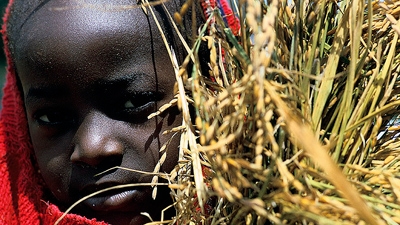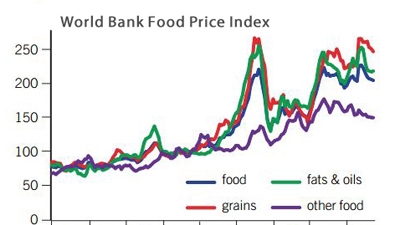Challenge
In mid-2008, the world experienced large spikes in key global food prices. The World Bank Food Price Index rose by 60 percent in the course of just a few months of 2008, and international prices of maize, rice, and wheat increased by 70 percent, 180 percent, and 120 percent, respectively, compared to the mid-2007. These price spikes were unexpected, and the impact on developing countries was large. They were estimated by the World Bank to have kept or pushed 105 million people into poverty in low-income countries.
After 2008, world food prices spiked twice. In early 2011, the Bank Food Price Index, after declining by 30 percent from mid-2008 to mid-2010, rose sharply, reaching its 2008 peak again in February 2011. Then, in mid-2012, world food prices escalated again. The Bank Food Price Index rose 14 percent from January to August 2012 as world maize prices soared to an all-time high in July 2012, surpassing their 2008 and 2011 peaks and rising 45 percent within a month.
These latter price spikes also had adverse impacts on developing countries, but overall the impact was smaller than in 2008, largely because many developing countries had increased their cereal production since 2008, had reduced their import bills, and fuel and fertilizer prices were at lower levels than in 2008. Countries also reacted more swiftly. The 2011 food price spike was estimated to have affected 40-44 million people in low- and middle- income countries.
Broad agricultural price increases sustained overtime pinpoint to structural weaknesses in the global food supply system. Higher global food prices and food price volatility have become a longer-term phenomenon, as indicated in the Spring 2011 Development Committee Report, Joint International Organizations Report to G20, and the World Bank’s 2012 Global Monitoring Report.
Price spikes and volatility are likely to continue for the foreseeable future, with persistent uncertainty on the supply side, including continued low grain stock levels, against projected rising demand and the inherent low responsiveness of the global food system to shocks. This long-term phenomenon requires a longer-term response.
Solution
An era of food crises reminiscent of the 1960s and 1970s seemed to return in 2008, prompting clients to request fast-disbursing financial support and urgent policy advice to help them cope with the food price crisis without creating further problems for the future. This led the World Bank to create the Global Food Crisis Response Program (GFRP).
The GFRP gave countries alternatives to the food emergency response policies of 1970s, many of which involved closing borders, government intervention in food and input markets, and other actions that had the effect of discouraging both smallholder and broader market-led investment in agriculture for many years.
In 2008, GFRP’s immediate efforts included boosting social protection, bolstering affected countries’ fiscal space, and maintaining short- and medium-term food production, with grant resources targeted to the poorest and most vulnerable countries. As time passed, country needs shifted to making social protection and food production systems more resilient to variable circumstances, and the nature of GFRP grants evolved to meet these demands.
Drawing upon expertise across the Bank, the GFRP financed stand-alone technical assistance, development policy lending, and investment operations under four components: food price policy and market stabilization; social protection actions to ensure food access and minimize the nutritional impact of the crisis on the poor and vulnerable; enhancement of domestic food production and marketing response; and implementation support, communications, and monitoring and evaluation.
The GFRP encompassed several funding sources, with an authorized ceiling on the use of Bank sourced-funds of US$1.2 billion in May 2008, later increased to US$2 billion in April 2009. Funding sources included a single-donor trust fund (the Food Price Crisis Response Trust Fund) of US$200 million from the IBRD surplus account, a further US$1.8 billion in headroom for fast-tracked loans from existing IDA and IBRD resources already available to countries, and several externally-funded trust funds supporting the full range of activities available under the GFRP.


